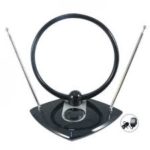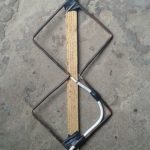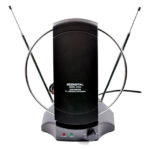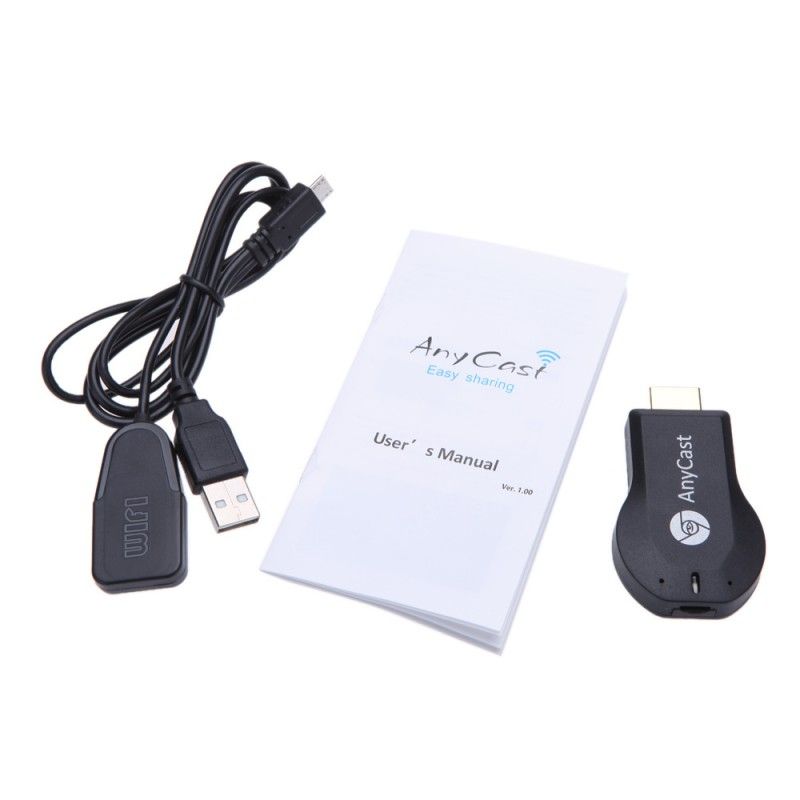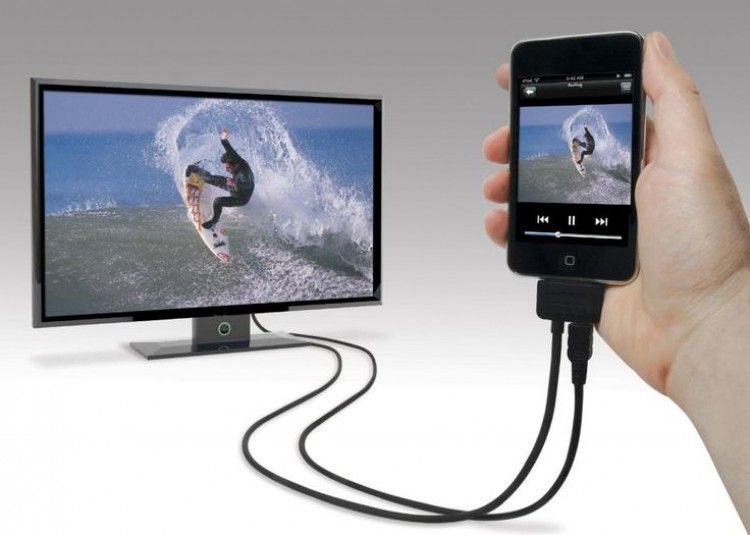How to make a TV antenna with your own hands
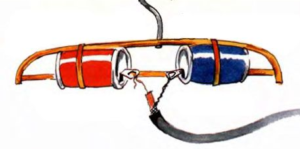 In our free time, we all love to watch a good series or movie on TV. Fortunately, some people have connected to Internet television a long time ago and few people need a television antenna. But there are those who still have the antenna. Imagine a situation where it is broken and all you can see is a gray screen. In this case, you can buy a new antenna or make it yourself.
In our free time, we all love to watch a good series or movie on TV. Fortunately, some people have connected to Internet television a long time ago and few people need a television antenna. But there are those who still have the antenna. Imagine a situation where it is broken and all you can see is a gray screen. In this case, you can buy a new antenna or make it yourself.
In this article you will learn about how to make an antenna from wire, how to make an antenna using beer cans and what types of television antennas there are.
The content of the article
How to make a TV antenna from wire
Based on the name, it is already clear that wire will be involved in the work (2 pieces of 180 cm each). We will also need:
- amplifier from an unnecessary old device;
- plastic or wooden plate with sides 15 by 15 cm;
- drill and drill bits;
- small bolts;
- hammer;
- metal pipe;
- cable for TV.
Step 1. In order to prepare a wave catcher, bend the wire into a diamond shape so that all sides are exactly 45 cm. These dimensions will be optimal for the device.
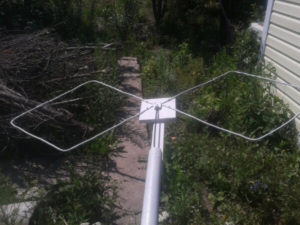
Step 2. To attach the wire to the plate, flatten the wires at the attachment points, drill holes and tighten the bolts. But a welding machine is also suitable for securing the wire to the plate (the plate in this case must be metal).
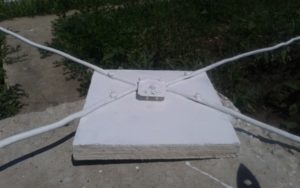
Step 3. Connect the TV cable in the resulting structure.
Step 4. Weld a metal pipe to the resulting structure using a soldering iron (you can use a drill and self-tapping screws) and fix it on the roof of the house or dig it into the ground. The pipe will play the role of a mast, elevating the structure itself.

The antenna is ready! The main advantage of such an antenna will be that its production will not take much time and expense. It’s also made with your own hands, which will bring a lot of pleasure when watching TV.
How to make a TV antenna from beer cans
Those who like to spend the weekend with a couple of cans of beer will probably have empty beer cans.
Important: It’s best to take 1L cans, but if you don’t have those, 0.75L and 0.5L cans will do.
We take 2 pieces, wash them thoroughly and dry them. In addition to cans, we will need:
- 4 meters of cable;
- soldering iron and tin;
- screwdriver;
- tape or tape;
- wooden hanger.
Step 1. To properly prepare the cable, cut it 10 cm from the edge and remove a small part of the top layer of insulation. Once you have access to the groove, roll it into one turn. Then cut off the middle layer of insulation, thereby exposing the thin copper core of the cable. At the other end of the television cable there should be a plug for connection to the outlet.

Step 2. We take the cans and, using a soldering iron, fix the contacts to the cans as shown in the photo.

Step 3. The receiver is ready. Now you need to make a supporting structure.We take a wooden hanger as a basis. Using electrical tape or tape, attach the tins to the hangers, as in the photo.
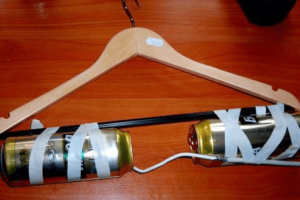
Important: both tins must be strictly on the same line, otherwise the signal quality will not be as high as we would like.
Step 4. All that remains is to install the antenna and enjoy your favorite program. By the way, the optimal place for the antenna is near a window.
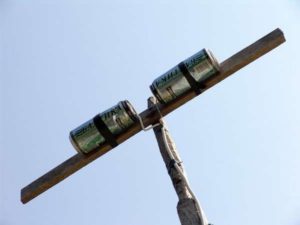 The beer can antenna is ready and does its job just as well as a wire antenna. The process itself is very simple and will not require you to spend a lot of time and effort.
The beer can antenna is ready and does its job just as well as a wire antenna. The process itself is very simple and will not require you to spend a lot of time and effort.
We make an antenna out of foil.
To make a simple but no less effective foil antenna, we will need:
- foil;
- cardboard;
- scocht;
- stapler;
- glue;
- roulette;
- marker;
- scissors.
Step 1. First, print out the templates on paper.
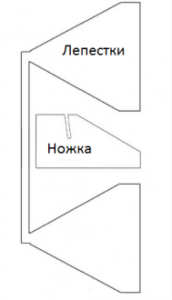
Step 2. Cut out the reflector from cardboard with sides 35 by 32.5 cm, then cover the part with foil on both sides.

Step 3. Cut out two small rectangles.

Step 4. Cut out the remaining parts using the template. If desired, you can paint the resulting parts with any color.

Step 5. Cut out the foil using a template.

Step 6. Glue the foil onto the vibrator of the structure on the so-called “butterfly”.

Step 7. Glue the “butterfly” at a distance of 3.5 cm from the reflector.

Step 8. In the center of the “butterfly” we drill a hole for the television cable.


The antenna is ready! A foil antenna will be an equally effective option for catching a signal, and will also not require much expense to create it.
How to make a simple TV antenna
To make the simplest version of a television antenna, you will need two thin metal rods, a metal mast cable and a soldering iron with tin.
Step 1. We bend both rods at an angle of 180 degrees.
Step 2. We attach the rods to the iron mast.

Step 3. We fix the television cable to the structure and fasten it to the roof.
The manufacturing process of this version of a television antenna will take no more than 5 minutes. In terms of signal capture, this antenna will be in many ways inferior to a wire antenna and an antenna made from beer cans.
Think about what is better: to spend a little more time and effort and make a high-quality antenna, or to spend a couple of minutes and get a product of poor quality.
Types of TV antennas
There are several types of antennas, which we will now discuss.
- Dipole. They come in several types: wave, half wave, quarter wave. For wave antennas, the size of the vibrator is equal to the wave size of the received signal. For half-wave, the vibrator size is 1/2 the wave size of the received signal, and for quarter-wave, it is 1/4. A dipole is a similar indoor antenna that comes with TVs.
- Wave channel antenna. This antenna is presented in the form of a set of a loop vibrator, a reflector and several directors, mounted on one boom. Passive vibrators located in front of the loop vibrator (active vibrator) are designated directors. And vibrators located behind the loop vibrator are called reflectors.
- Log-periodic antennas. These are devices that provide maximum signal capture with a wide frequency range. The operating frequency length of such an antenna is limited by the sides of the maximum or minimum antenna vibrators.
- Common Mode Antenna Array is presented in the form of a complex directional antenna system, which consists of individual omnidirectional antennas.Most often, such devices are assembled from identical antennas arranged in 2-3 rows at the same level. Such an antenna picks up waves at low and high range frequencies with the highest quality.
- Polish antenna. This model looks like a four-story in-phase array, which is equipped with an internal amplifier. The antenna is equipped with an active vibrator in the form of a lattice, which is located behind the antenna. The Polish antenna began to be widely used back in the 90s, when there was not a large selection of antennas on the market. By the way, the antenna was produced in those same years.
- Traveling wave antenna. This is a directional antenna through which the traveling wave of the captured signal passes. Often such an antenna is represented by a collective straight line. Several reflectors are connected to it, which are located at an equal distance from each other.
Useful tips on how to make a TV antenna with your own hands
- In order for any antenna (including homemade one) to capture the signal as efficiently as possible, it must be installed at a height of 7–10 meters. When climbing to such a height, do not forget about safety rules.
- Never install the antenna in rain or thick fog.
- In severe ice conditions, it is not recommended to climb to such a height alone and without insurance/protection.
If you decide to assemble one of the designs described above and follow all the rules at home, you will get an effective and powerful signal receiver that is in no way inferior to factory models.

